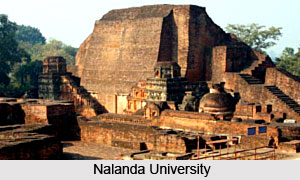 Ishanavarman is considered as the first ruler of the Maukhari Empire. The clay seal of General Cunningham reveals that Maukharis were the original inhabitants of Anga or south Bihar. Later they migrated to Uttar Pradesh. All members of the clan had names ending with Varmana, like Ishanavarman, Anatavarman, Grahavarman and so on. The Maukharis were feudatories of the Later Guptas in the regions of South Bihar and Uttar Pradesh in the beginning of the 6th century A.D. They rose to prominence by taking advantage of the decline of Gupta Power by the middle of the sixth century A.D. Hari Varman Maukhari had assumed the title `Maharaja` however the extent of his kingdom is unknown.
Ishanavarman is considered as the first ruler of the Maukhari Empire. The clay seal of General Cunningham reveals that Maukharis were the original inhabitants of Anga or south Bihar. Later they migrated to Uttar Pradesh. All members of the clan had names ending with Varmana, like Ishanavarman, Anatavarman, Grahavarman and so on. The Maukharis were feudatories of the Later Guptas in the regions of South Bihar and Uttar Pradesh in the beginning of the 6th century A.D. They rose to prominence by taking advantage of the decline of Gupta Power by the middle of the sixth century A.D. Hari Varman Maukhari had assumed the title `Maharaja` however the extent of his kingdom is unknown.
Advaita Varman, who had succeeded his father, is said to have assumed the title of Maharaja. However the real founder of Maukhari supremacy in ancient India was Ishanavarman. He assumed the title `Maharajadhiraja` in 554 A.D. Maukhari kingdom had stretched to Andhra Pradesh, Orissa and Gauda under his reign. The Andhra king defeated by Ishanavarman may have been a member of the Visnukundin family. Ishanavarman had to face opposition from the Later Guptas. He had started a prolonged struggle with the later Guptas but had suffered crushing defeats in their hands. A hereditary struggle had begun between the Maukharis and the Guptas. They are remembered in history was the resistance offered by Ishanavarman and the Huns, resulting in the defeat of the Huns. The Maukharis possibly fought with the Huns as feudatories of Baladitya of the Imperial Gupta family. The Harsha inscription depicted that Ishanavarman also had defeated the Sulikas. The seals and coins of this ruler indicate that he was a learned person, a just ruler, a brave warrior and a patron of education.
Sarvavarman (560-5 to 585 A.D) is probably the son of Ishanavarman who succeeded the throne after his father`s death. Sarvavarman did maintain his hold on Magadha. He kept later Guptas under subordination. Asirgadh in Nimar District of Madhya Pradesh was a "Maukhari outpost in the Deccan". The Nalanda seal shows that Sarvavarman was succeeded by his son Maharajadhiraja Avanti Varman (585-600 A.D.) In the time of Sarvavarman the Later Guptas created no trouble. There was no friendship between the two dynasties which characterised their relationship in the earlier period.
Avanti Varmana extended the boundary of the kingdom by transferring the capital to the historical city of Kannauj. Under Avanti Varman the Maukhari Empire reached at its height. Grahavarman had succeeded Avanti Varmana. He had married Rajyasri, the daughter of Prabhakar Vardhana of the Pushabhukti House of Thanesar. Grahavarman was killed by Deva Gupta of the later Gupta line. North India was attacked from different directions during the rule of Jayganga which brought a chaos thereby reducing the Maukharis to an insignificant local dynasty. The Maukhari family disappeared into obscurity.






































